SWEN20003 Object Oriented Software Development Project 2, Semester 2, 2023
Hello, dear friend, you can consult us at any time if you have any questions, add WeChat: daixieit
SWEN20003 Object Oriented Software Development
ShadowDance
Project 2, Semester 2, 2023
Overview
In this project, you will create a music arcade game called ShadowDance in the Java programming language, continuing from your work in Project 1. We will provide a full working solution for Project 1; you may use all or part of it, provided you add a comment explaining where you found the code at the top of each file that uses the sample code.
This is an individual project. You may discuss it with other students, but all of the imple- mentation must be your own work. By submitting the project you declare that you understand the University’s policy on academic integrity and are aware of consequences of any infringement, including the use of artificial intelligence.
You may use any platform and tools you wish to develop the game, but werecommend using IntelliJ IDEA for Java development as this is what we will support in class.
Extensions & late submissions: If you need an extension for the project, please complete the Extension form in the Projects module on Canvas. Make sure you explain your situation with some supporting documentation such as a medical certificate, academic adjustment plan, wedding invitation, etc. You will receive an email saying if the extension was approved or if we need more information.
If you submit late (either with or without an extension), please complete the Late form in the Projects module on Canvas. For both forms, you need to be logged in using your university account. Please do not email any of the teaching team regarding extensions or late submissions. All of this is explained again in more detail at the end of this specification.
There are two parts to this project, with different submission dates. The first task, Project 2A, requires that you produce a class design demonstrating how you plan to implement the game. This should be submitted in the form of a UML diagram showing all the classes you plan to im- plement, the relationships (e.g. inheritance and associations) between them, and their attributes, as well as their primary public methods. You do not need to show constructors, getters/setters, dependency, composition or aggregation relationships. If you so choose, you may show the relation- ship on a separate page to the class members in the interest of neatness, but you must use correct UML notation. Please submit as a PDF file only on Canvas.
The second task, Project 2B, is to complete the implementation of the game as described in the rest of this specification. You do not need to strictly follow your class design from Project 2A; you will likely find ways to improve the design as you implement it. Submission will be via GitLab and you must make at least 5 commits throughout your project.
Game Overview
‘The aim is simple : the player has to hit the corresponding musical notes that appear on screen in different lanes on time to score points. To win each level, you need to beat a target score. The second level features a special lane that has special notes such as bomb, speed up, slow down and double score. The third level includes enemies who try to steal notes from the lanes and a guardian who will shoot projectiles at these enemies when a key is pressed. Can you beat the target scores and win the game?”
The game features three levels : Level 1, Level 2 and Level 3. In Level 1, the notes will de- scend from the top vertically in the 4 lanes. The player has to press the corresponding arrow key when the note overlaps with the stationary note symbol at the bottom. The accuracy of how close the note was to the stationary note when the key was pressed, will determine the points given. There will be hold notes that require the player to hold down the key. To finish the level, the player needs to beat the target score of 150 when all the notes have fallen. If the player’s score is lower, the game ends. You have already implemented Level 1 in Project 1 (the only change required is to the start/end screens which is explained later).
Level 2 features the same game-play as above but the player now has to deal with additional features such as a special lane that has special notes. Similar to a normal note, if the corresponding key is pressed for the special note, its effect is applied (this is explained in detail later). To win the level, the player must beat a score of 400.
Level 3 is the final level. It includes all of the above as well as extra features such as enemies and a guardian. An enemy moves horizontally and it will steal notes from nearby lanes by colliding with them. The guardian will shoot projectiles at the nearest enemy when the corresponding key is pressed. To win the level, the player must beat a score of 350.
Note that the game does not need to be played progressively. You can choose which level to play from the start screen and also at the end of each level.
An Important Note
Before you attempt the project or ask any questions about it on the discussion forum, it is crucial that you read through this entire document thoroughly and carefully. We’ve covered every detail below as best we can without making the document longer than it needs to be. Thus, if there is any detail about the game you feel was unclear, try referring back to this project spec first, as it can be easy to miss some things in a document of this size. And if your question is more to do on how a feature should be implemented, first ask yourself: ‘How can I implement this in a way that both satisfies the description given, and helps make the game easy and fun to play?’ More often than not, the answer you come up with will be the answer we would give you!
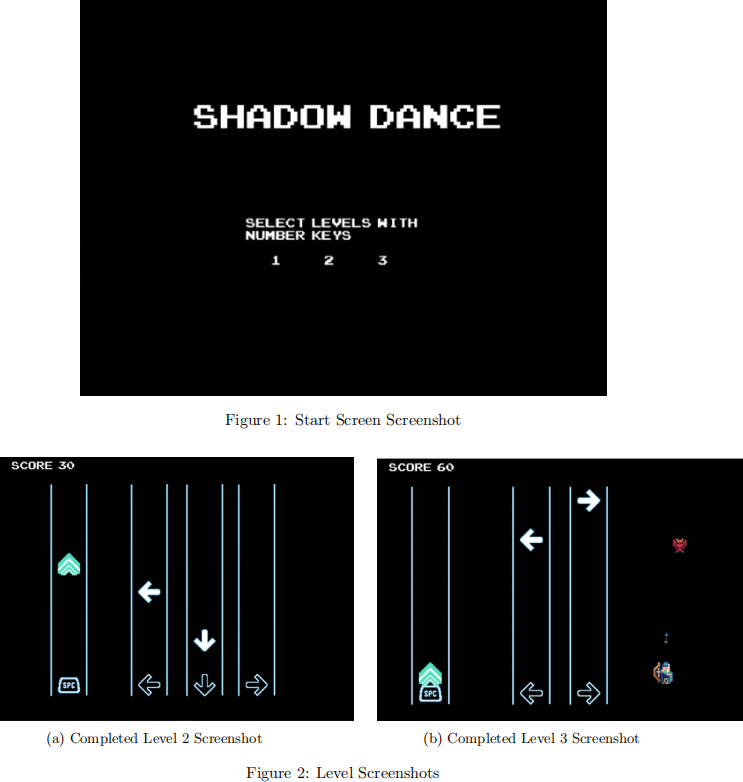
Note : the actual positions of the entities in the levels we provide you may not be the same as in these screenshots.
The Game Engine
The Basic Academic Game Engine Library (Bagel) is a game engine that you will use to develop your game. You can find the documentation for Bagel here.
Coordinates
Every coordinate on the screen is described by an (x,y) pair. (0, 0) represents the top-left of the screen, and coordinates increase towards the bottom-right. Each of these coordinates is called a pixel. The Bagel Point class encapsulates this.
Frames
Bagel will refresh the program’s logic at the same refresh rate as your monitor. Each time, the screen will be cleared to a blank state and all of the graphics are drawn again. Each of these steps is called a frame. Every time a frame is to be rendered, the update() method in ShadowDance is called. It is in this method that you are expected to update the state of the game.
Your code will be marked on 120Hz screens. The refresh rate is now typically 120 times per second (Hz) but some devices might have a lower rate of 60Hz. In this case, when your game is running, it may look different to the demo videos as the constant values in this specification have been chosen for a refresh rate of 120Hz. For your convenience, when writing and testing your code, you may change these values to make your game playable (these changes are explained later). If you do change the values, remember to change them back to the original specification values before submitting, as your code will be marked on 120Hz screens.
The Levels
Our game will have three levels, each with elements to implement that are described below.
Window and Background
The background (background.png) should be rendered on the screen to completely fill up your window throughout the game (for the start screen and all the levels). The default window size should be 1024 * 768 pixels. The background has already been implemented for you in the skeleton package.
Start Screen
Each level has the same start screen. The screen has a title message that reads SHADOW DANCE should be rendered in the font provided in res folder (FSO8BITR.ttf), in size 64. The bottom left corner of this message should be located at (220, 250).
Additionally, an instruction message consisting of 4 lines:
SELECT LEVELS WITH
NUMBER KEYS
1 2 3
should be rendered below the title message, in the font provided, in size 24. The bottom left of the first line in the message should be calculated as follows: the x-coordinate should be increased by 100 pixels and the y-coordinate should be increased by 190 pixels.
There must be adequate spacing between the 4 lines to ensure readability (you can decide on the value of this spacing yourself, as long as it’s not small enough that the text overlaps or too big that it doesn’t fit within the screen). You can align the lines as you wish.
The player chooses which level to play by pressing the corresponding key (1, 2 or 3). Once the level is over, the player will be re-directed back to the start screen. To help when testing your game, you can allow the player to pause the game whilst in a level (i.e. everything in the window will stop moving) by pressing the Tab key (this is not assessed but will help you when coding!)
World File
The lanes and the notes will be defined in a world file, describing the type and their position or time of appearance in the window. The world files for each level are level1.csv, level2.csv and level3.csv correspondingly. (For 60Hz screens, use the corresponding ‘-60” file, i.e. for Level 1 use level1-60.csv). A world file is a comma-separated value (CSV) file with rows in one of the following formats:
Lane, type of lane, x-coordinate
(or)
Type of lane, type of note, frame-number
An example of a world file:
Lane,Special,200
Lane,Right,742
Down,Normal,776
Down,Hold,1357
Special,DoubleScore,2370
The type of lane refers to either the arrow key which it corresponds to or if it is a special lane, for example: the first entry in the above example is for the lane corresponding to the special lane. The type of note refers to whether the note is normal, a hold note or a special note, and the frame number is the frame in which the note starts appearing on screen. For example, the last entry in the above example refers to a special note of the double score type that appears from the 2370th frame onwards in the special lane.
You must actually load the files—copying and pasting the data, for example, is not allowed. You have been provided with extra world files to test on (test1.csv, test2.csv, test3.csv). Marking will be conducted on a hidden different CSV file of the same format. Note: You can assume that there will always be only one special lane in both Levels 2 and 3, and that there will be a maximum of four normal lanes in each level. The number of notes in the CSV may vary however.
End Screen
Each level has the same end screen. The end screen has two messages - a win/loss message and an instruction message.
When all the notes in the CSV file have fallen, if the player’s score is higher than the target score for that level, this is considered as a win. Hence, the first message is a winning message that reads CLEAR! The x-coordinate of this message should be centered horizontally and the y-coordinate is 300. The font size to be used is 64. If the player’s score is less than the target score of the level, this is a loss. In this case, the message reads TRY AGAIN. The coordinates and the font size are the same as previously mentioned. The target scores for each level are 150, 400 and 350 respectively.
The second message on the end screen is an instruction message that reads PRESS SPACE TO RETURN TO LEVEL SELECTION. This should be rendered below the first message. The x-coordinate should be centered horizontally and the y-coordinate is 500. The font size to be used is 24.
When the player presses the space key, the start screen should be rendered again as described in the Start Screen section and the player can choose to play again. The player can terminate the game window at any point (by pressing the Escape key or by clicking the Exit button) - the window will simply close and no message will be shown.
Hint: The drawString() method in the Font class uses the given coordinates as the bottom left of the message. So to center the x-coordinate of the message, you will need to calculate the coordinate using the Window.getWidth() and Font.getWidth() methods.
The Game Entities
The following game entities have an associated image (or multiple!) and a starting location (x, y). Remember that all images are drawn from the centre of the image using these coordinates.
Lane
In this game, there are four normal lanes for the four arrow keys (left, right, up and down) represented by the images shown on the next page. The (x, y) coordinate of the centre of each image is as follows : the x-coordinate is given in the CSV file and the y-coordinate is 384. The position of the lane stays constant throughout the game.
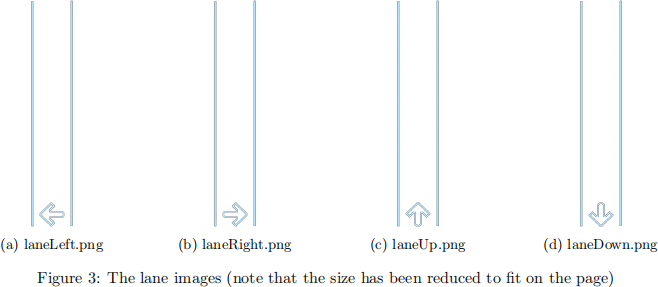
A lane can have any number of notes and hold notes. Each lane has a stationary note symbol at the bottom which is the target. The player needs to press the corresponding arrow key when the falling note overlaps with the stationary note to score points. The y-coordinate of the centre of the four stationary notes is 657.
Special Lane
This is a special type of lane shown below that features in Level 2 and 3. Only special notes will fall down this lane. The player needs to press the space key when the falling special note overlaps with the stationary symbol at the bottom of the lane, to activate the effect of the special note. Only one special lane will be present in one level. The y-coordinates mentioned in the previous section are the same for special lanes too.
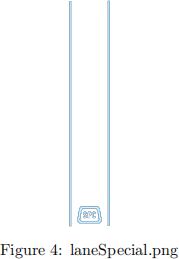
Note

There are four types of normal notes for the four arrow keys represented by the above images. Each note will descend vertically from the top of the screen in the corresponding lane, for example: a left note should descend in the left lane and an up note should descend in the up lane. The starting (x, y) coordinate of the centre of each note image is as follows : the x-coordinate is the same as the x-coordinate of the lane it corresponds to and the y-coordinate is 100.
Each note moves downwards at a speed of 2 pixels per frame (for 60Hz screens, increase this value to 4). The frame number from which the note starts being drawn on screen is given in the CSV file. The note will continue to be drawn until either it either leaves the window from the bottom of the screen or the player presses the corresponding key for the note (and a score is calculated as described below).
Note Scoring
The score for each key press is calculated based on the accuracy of how close the given note was to the stationary note symbol in the lane when the key was pressed. When the key is pressed, the absolute distance in pixels between the y-coordinate of the centre of the falling note and the y-coordinate of the centre of the stationary note is calculated. The method to determine the score from this distance is shown below.
. If distance <= 15, this is a PERFECT score and receives 10 points
. If 15 < distance <= 50, this is a GOOD score and receives 5 points
. If 50 < distance <= 100, this is a BAD score and receives -1 points
. If 100 < distance <= 200, this is a MISS and receives -5 points.
If the note leaves the window from the bottom of the screen without the corresponding key being pressed, this is considered as a MISS too and receives -5 points.
When a score is calculated, the corresponding score message (shown in the list above) must be rendered on screen, roughly centered horizontally and vertically. The font size must be set to 40 and the message must be rendered for 30 frames (15 frames for 60Hz screens). For example, when the score is perfect, the text rendered must be PERFECT.
The player’s current total score must also be rendered on screen. The score is rendered in the top left corner of the screen in the format of "SCORE k" where k is the current score. The bottom left corner of this message should be located at (35, 35) and the font size should be 30. 
Hold Note
A hold note is a different type of normal note, where the player has to hold down the corresponding arrow key for the duration in which the falling hold note overlaps with the stationary note in the lane. Once again, there are four types of hold notes for the four arrow keys shown in the figure below.
The starting (x, y) coordinate of the centre of each image is as follows : the x-coordinate is the same as the x-coordinate of the lane it corresponds to and the y-coordinate is 24. The speed is the same as for a normal note and the frame number is also given in the CSV file.
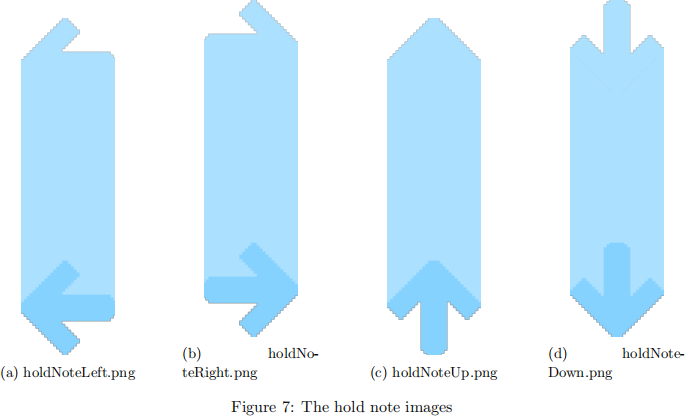
Hold Note Scoring
For hold notes, the scoring is calculated in a similar manner but the difference is that two scores are calculated - first when the hold is started and the second when the hold is released. Hint: To check if a hold has been released, you will find the wasReleased() method in the Input class helpful.
When the hold starts, the y-coordinate at the bottom of the image of the holding note needs to be used to calculate the distance (instead of the centre of the image like in a normal note). Likewise when the hold is released, the y-coordinate at the top of the image needs to be used. Hint: To calculate the y-coordinate at the bottom of the hold note image, add 82 to the centre y-coordinate, and for the y-coordinate at the top of the image, subtract 82.
The method of determining the score from the distance is the same as given in the Note Scoring section (bottom of page 8). If the hold note leaves the window from the bottom of the screen without the hold starting, this is considered as a MISS and receives -5 points. If the hold was released at a distance greater than 200 pixels, this is a MISS too.
Similar to normal notes, the score messages should also be rendered on screen and the scores from hold notes, need to be added to the total score too.
Special Note
A special note is a special type of normal note that features in Levels 2 and 3. Similar to normal notes, each note has a starting (x, y) coordinate, where the x-coordinate is the same as the x-coordinate of the lane it corresponds to and the y-coordinate is 100.
Instead of a score, each special note has an effect that activates when the key for the lane it corresponds to is pressed. The distance calculation is simpler than the other notes - if the distance between the y-coordinate of the stationary note (at the bottom of the lane) and the y-coordinate of the special note is <= 50, it is considered as activated. When activated, a message is rendered on screen similar to the scoring messages for normal and hold notes. The 4 types of special notes are described below.
Double Score Note
This note can only appear in the special lane and is represented by the image on the right. The special effect of this note is that all scores are doubled temporarily. The message to be rendered when activated reads Double Score. The effect lasts for 480 frames and scoring returns to nor-mal after this elapses. 
Speed Up Note
 This note can only appear in the special lane and is represented by the image on the left. Its special effect is that the speed of all notes is in- creased by 1. The message to be rendered when activated reads Speed Up and 15 points is added to the score. The effect lasts until a slow down note is activated.
This note can only appear in the special lane and is represented by the image on the left. Its special effect is that the speed of all notes is in- creased by 1. The message to be rendered when activated reads Speed Up and 15 points is added to the score. The effect lasts until a slow down note is activated.
Slow Down Note
This note can only appear in the special lane and is represented by the image on the right. The special effect of this note is the speed of all notes is decreased by 1. The message to be ren- dered when activated reads Slow Down and 15 points is added to the score. 
Bomb Note
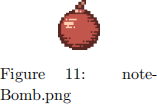 This note can appear in any of the normal lanes or in the special lane. It is represented by the image on the left. The special ef- fect of this note is that all notes in that lane will be removed from the screen. The message to be rendered when activated reads Lane Clear.
This note can appear in any of the normal lanes or in the special lane. It is represented by the image on the left. The special ef- fect of this note is that all notes in that lane will be removed from the screen. The message to be rendered when activated reads Lane Clear.
Enemy
The enemy is an entity that appears in Level 3 and is represented by the image on the right. In Level 3, every 600 frames, an enemy must be created. At creation, the enemy’s (x, y) coordinates must be chosen as follows : the x-coordinate must be randomly chosen between 100 and 900, the y-coordinate must be randomly chosen between 100 and 500. 
An enemy can move horizontally at a speed of 1 pixel per frame either in the left direction or right direction, and this must also be chosen randomly at creation.
When the enemy’s x-coordinate reaches either 100 or 900, the enemy must start moving in the opposite direction (i.e. the enemy will reverse direction at these coordinates). The enemy’s goal is to steal normal notes from lanes by colliding with them. Collisions are detected as follows: if the distance between the centre-coordinates of the enemy image and the centre-coordinates of the note image is <= 104, this is considered as a collision. If collided with, the note will disappear from the screen.
Guardian
 The guardian is an entity that appears in Level 3 and is represented by the image on the left. The guardian does not move and remains at (800, 600) throughout. When the left shift key is pressed, the guardian will fire a projectile at the nearest enemy to its location. The nearest enemy is found by finding the enemy with the closest distance calculated once again using the centre of the respective images.
The guardian is an entity that appears in Level 3 and is represented by the image on the left. The guardian does not move and remains at (800, 600) throughout. When the left shift key is pressed, the guardian will fire a projectile at the nearest enemy to its location. The nearest enemy is found by finding the enemy with the closest distance calculated once again using the centre of the respective images.
Projectile
A projectile gets created by the guardian when attacking an enemy and is rendered using the image on the right. A projectile moves at a speed of 6 pixels per frame in the direction of the enemy target which is set at creation. Its image should be rotated in the direction of the enemy. 
For example, if the guardian is at the coordinate (3,3) and the enemy is at the coordinate (13,8), the projectile should be fired with its image rotated by 0.464 radians. The diagram below illustrates how this can be calculated (note that the positions given are for explanation and may not reflect in-game positions).
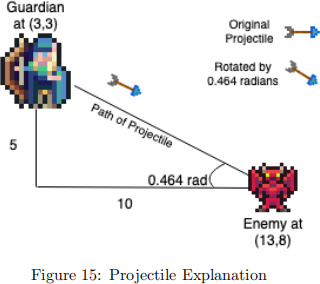
If the projectile collides with the enemy, the enemy will disappear from the screen. Collisions are detected as follows: if the distance between the centre-coordinates of the enemy image and the centre-coordinates of the projectile image is <= 62, this is considered as a collision. If the projectile reaches the edges of the window without colliding with an enemy, the projectile needs to stop being updated (rendered).
Hint: To deal with velocities, you many find it useful to use the Vector2 class in Java. To rotate an Image in Bagel, you can include a DrawOptions parameter in the draw() method. A DrawOptions instance allows you to specify detailed options for drawing images, and has a setRotation() method for setting the rotation value, measured in radians. You may need to use one of the trigonometric functions from Java’s inbuilt Math class to calculate this value. Feel free to round up the value you calculate as needed, as long as the image’s final rotation looks correct.
Sound
Note that this section is optional and you will not be assessed on this.
If you want to add sound, you may use the same music demo from Project 1. Two new tracks
(track2.wav and track3.wav) have been provided in the res folder for you to use with Level 2 and 3.
Your Code
You must submit a class called ShadowDance that contains a main method that runs the game as prescribed above. You may choose to create as many additional classes as you see fit, keeping in mind the principles of object oriented design discussed so far in the subject. You will be assessed based on your code running correctly, as well as the effective use of Java concepts. As always in software engineering, appropriate comments and variables/method/class names are important.
Implementation Checklist
To get you started, here is a checklist of the game features, with a suggested order for implementing them (in addition to the features in Project 1):
. Implement the new level start screen.
. Implement the Level end screen.
. Read the Level 2 CSV file.
. Implement the special lane and special notes’ behaviour/logic.
. Implement Level 2.
. Read the Level 3 CSV file.
. Implement the enemy, guardian and projectile behaviour/logic.
. Implement Level 3.
Supplied Package and Getting Started
You will be given a package called project-2-skeleton.zip that contains the following: (1) Skeleton code for the ShadowDance class to help you get started, stored in the src folder. (2) All graphics and fonts that you need to build the game, stored in the res folder. (3). The pom.xml file required for Maven. You should use this template exactly how you did for Project 1, that is:
1. Unzip it.
2. Move the content of the unzipped folder to the local copy of your [username]-project-2] repository.
3. Push to Gitlab.
4. Check that your push to Gitlab was successful and to the correct place.
5. Launch the template from IntelliJ and begin coding.
6. Commit and push your code regularly.
Customisation (optional)
We want to encourage creativity with this project. We have tried to outline every aspect of the game design here, but if you wish, you may customise any part of the game, including the graphics, types of actors, behaviour of actors, etc (for example, an easy extension could be to introduce a new level with different entities). You can also add entirely new features. For your customisation, you may use additional libraries (other than Bagel and the Java standard library).
2023-09-16